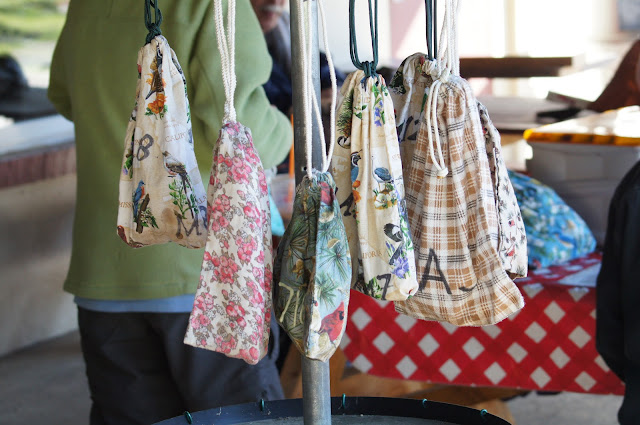There are mist nets set up around the Auburn Sportsman's Club's property. Trained volunteers open the nets at sunrise (today around 5AM), then regularly check them for birds. Small, soft, numbered drawstring bags are used to transport the birds from the nets back to the banding station. A rack is set up at the station where the bags are hung as they deal with the birds one or two at a time. While in the field, the volunteers log the type of bird captured and the bag number so that they know what size bird is in the bag without having to open it up.
"Bags Contain Live Birds"
From what I read on line, volunteers start their training with larger, tougher birds, like catbirds, and as they gain experience, move on to the smaller, more delicate warblers. Also, the size of the bird affects what tools and banding equipment they will use and want to have ready before the bird comes out of the bag.
Baltimore Oriole (male)
Volunteers are taught to hold the birds legs as close to the body as possible, because the legs are fragile and could break if they hold them too close to the "elbow" bend.
Scarlet Tanager (repeat capture - see the tiny tag?)
Scarlet Tanager
(photo op before being released)
Scarlet Tanagers (female on right)
They kept them far enough apart in case they were not a couple.
When birds are re-captured, it is a sign that they are staying local and are "breeding" birds.
Measuring the wing
The scale
The various tubes were for the various sizes of birds. When a bird was weighed, it was placed head-first into the tube onto the scale.
They invited me to go along when they did the final net check. This is what a mist net looks like. When they close the nets, they roll them up and tie them tightly so that nothing can get caught in them when they are not being checked.
Common Yellowthroat
So much of this visit was about education and inspiring awe of these tiny travelers. The range of the bird was called up on an iPad. Many had migrated from South America. The leader, Mark Blazis, was not only training future banders, but also teaching about the birds themselves, from what their range is... to how to tell the age. Mary, another bander, also pointed out a brooding spot on a Song Sparrow that was caught. She taught us that a brooding spot is a bald spot on the bird's belly which goes directly onto the eggs in the nest, creating the most warmth. The feathers then close in around it. I had never heard of that before. I always assumed the feathers kept the eggs warm.
The pond at the Sportman's Club had just been stocked, and there were a lot of guys fly fishing. Those who came over to the lodge to relax at the picnic tables showed an interest in the birds and couldn't believe how far they had come (and multiple times over the years, too).
The volunteers were so respectful and careful with the birds. You could tell they really felt strongly about what they were doing and care deeply about it. I recommend a visit to anyone who lives near by! You'll learn a lot! Make sure you look in the rafters above the picnic tables. There's a nesting Eastern Phoebe there.


















No comments:
Post a Comment